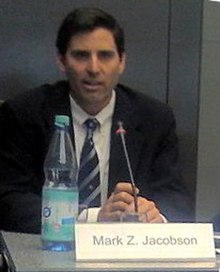Mark Z. Jacobson
| Mark Z. Jacobson | |
|---|---|
 |
|
| Born | Mark Zachary Jacobson 1965 (age 51–52) |
| Institutions |
University of California, Los Angeles Stanford University |
| Alma mater | University of California, Los Angeles |
| Thesis | Developing, coupling, and applying a gas, aerosol, transport, and radiation model to study urban and regional air pollution (1994) |
| Doctoral advisor | Richard P. Turco |
|
Website stanford |
|
Mark Zachary Jacobson (born 1965) is professor of civil and environmental engineering at Stanford University and director of its Atmosphere and Energy Program. Jacobson develops computer models about the effects of different energy technologies and their emissions on air pollution and climate. He has done influential research on the role of aerosols and black carbon on the climate and is regarded as a leading aerosol climate modeler.
According to Jacobson, a speedy transition to clean, renewable energy is required to reduce the potential acceleration of global warming, including the disappearance of the Arctic Sea ice. This change will also eliminate 2.5–3 million deaths worldwide each year, related to air pollution, and reduce disruption associated with fossil fuel shortages.
Using computer modeling he developed over 20 years, Jacobson has found that carbonaceous fuel soot emissions (which lead to respiratory illness, heart disease and asthma) have resulted in 1.5 million premature deaths each year, mostly in the developing world where wood and animal dung are used for cooking. Jacobson has also said that soot from diesel engines, coal-fired power plants and burning wood is a "bigger cause of global warming than previously thought, and is the major cause of the rapid melting of the Arctic's sea ice".
Jacobson conducted several studies about 100% renewable energy systems and renewable energy integration and concluded that wind, water, and solar power can be scaled up in cost-effective ways to fulfill our energy demands, freeing human society from dependence on both fossil fuels and nuclear power. In 2009 Jacobson and Mark A. Delucchi published "A Plan to Power 100 Percent of the Planet With Renewables" in Scientific American. The article addressed several issues, such as the worldwide spatial footprint of wind farms, the availability of scarce materials needed for manufacture of new systems, the ability to produce reliable energy on demand, and the average cost per kilowatt hour. A more detailed and updated technical analysis has been published as a two-part article in the journal Energy Policy in 2010. "Providing all global energy with wind, water, and solar power". The articles analyze the feasibility of providing worldwide energy for all purposes (electric power, transportation, heating/cooling, etc.) from wind, water, and sunlight (WWS). In Part I, Jacobson and Delucchi discuss WWS energy system characteristics, current and future energy demand, availability of WWS resources, numbers of WWS devices, and area and material requirements. They estimate that 3,800,000 5 MW wind turbines, 49,000 300 MW concentrated solar plants, 40,000 300 MW solar PV power plants, 1.7 billion 3 kW rooftop PV systems, 5350 100 MW geothermal power plants, and 270 new 1300 MW hydroelectric power plants will be needed. Such a WWS infrastructure reduces world power demand by 30% and requires 0.41% and 0.59% more of the world's land for footprint and spacing, respectively.
...
Wikipedia
